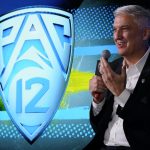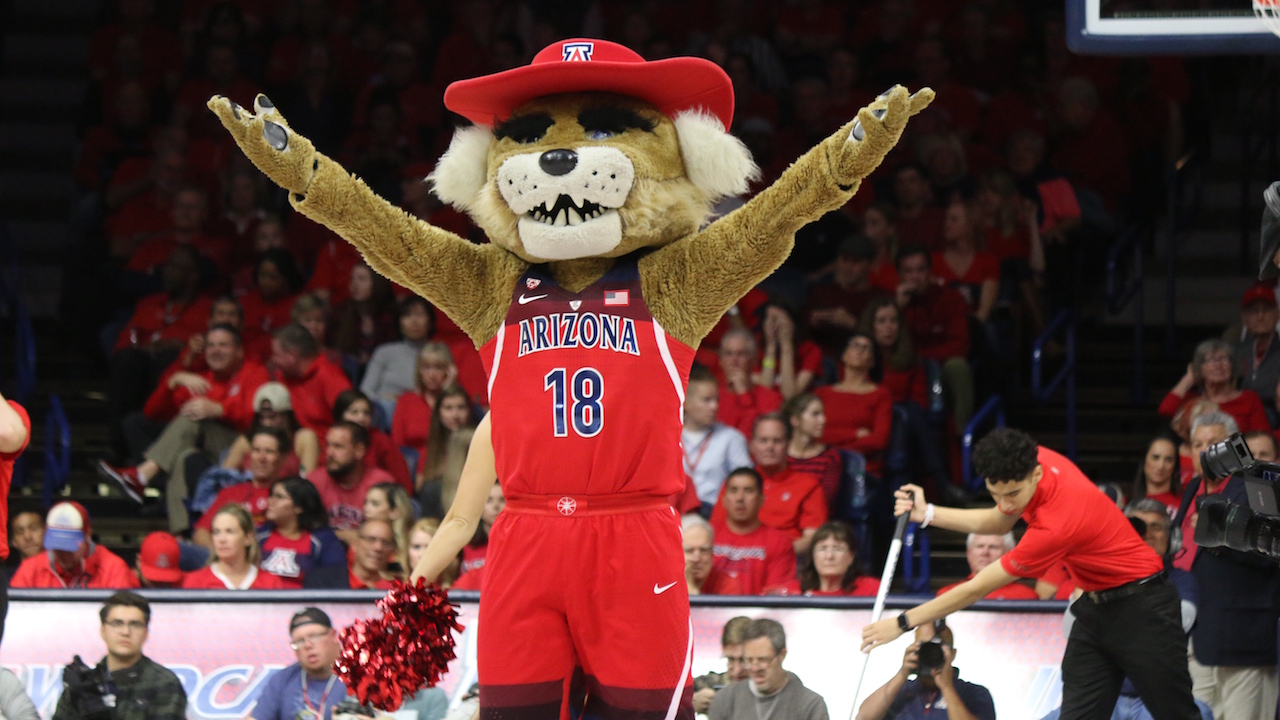The landscape of college sports changed forever on Friday
Two weeks ago, at the Pac-12’s preseason media extravaganza in Las Vegas, commissioner George Kliavkoff offered a succinct, confident view of the college sports landscape. “We’ll get our media rights deal done, we’ll announce the deal,” he said. “I think the realignment that’s going on in college athletics will come to an end for this cycle.”
He only missed by six schools.
After a mass exodus that decimated the 108-year-old conference, the 2023 cycle of realignment appears to be over. (Caveat: See the section on the ACC below.)
Our look at the winners and losers …
Loser: West Coast college sports. The future for eight athletic departments is secure: Washington, Oregon, USC and UCLA will enter the Big Ten next summer while Arizona, ASU, Colorado and Utah are bound for the Big 12. The future for Washington State, Oregon State, Stanford and Cal is murky. But for everyone involved — the players and coaches, fans and alumni — the sporting scene will never be the same. At its heart, at its best, college football is a regional sport with traditions and rivalries as the foundation. That’s gone, perhaps forever, as the schools chase the media money and the sport rapidly morphs into a mini-NFL.
Winner: Fox. The owner of the Big Ten’s media rights orchestrated the 2022 raid that grabbed USC and UCLA and pushed the Pac-12 into crisis mode. This week, Fox returned for the kill shot, providing the dollars behind the offers to Oregon and Washington that ultimately doomed the conference. As a result, the network will control the media rights for the top brands in the Pacific Time Zone (USC, UCLA, Oregon and UW) and leave its rival, ESPN, without premium West Coast inventory. As we have written numerous times over the years, the conferences and schools are pawns in the chess game played by the two networks. Outside the multi-year collective of Pac-12 presidents, no single entity is more responsible for the Pac-12’s destruction than Fox.
Losers: Washington State and Oregon State. The Pacific Northwest ‘State’ schools with precarious financial situations are facing uncertain futures in a dying league, victims of their geography and resources more than competitive performance. Relocation options are few; good relocation options are nonexistent. The Cougars and Beavers are the deeply unfortunate poster schools for realignment at its most unforgiving.
Winner: Arizona fans. None of the longstanding Pac-12 universities (i.e., excluding Colorado) fit better in the Big 12 than Arizona, a basketball school that will join a basketball league. (Its geography also works for frequent travel throughout the Southern Plains.) Then again, be careful what you wish for. Are two games a year against Kansas worth the toll in conference losses, lower seeds and tougher roads in the NCAA Tournament? It will be fascinating to watch the trajectory of Arizona’s program over the next decade.
Loser: Stanford and Cal. As difficult as it might be to imagine, two schools with hundreds of NCAA titles and Nobel Prizes — plus access to the Bay Area tech scene — are on the brink of losing Power Five status. Sure, they have struggled on the field, but there are plenty of second-tier football programs across the major conferences. Stanford has the resources to sustain a demotion; Cal does not. Both schools are undoubtedly pursuing membership in the Big Ten at huge discounts … and with faint hopes.
Winner: Mountain West. The conference thought it would lose San Diego State to the Pac-12. Instead, it kept the Aztecs and could very well add the Pac-12’s remaining quartet. If Stanford rises under new coach Troy Taylor and joins quality programs like Boise State, Fresno State and SDSU, the resulting 16-team MW would generate a highly-competitive football product. (For years, the difference between the bottom two-thirds of the Pac-12 and the top third of the MW has been negligible.) That said, we should acknowledge the possibility of the Pac-4 sticking together and executing a raid of the top programs in the MW.
Loser: Second-tier schools in the Big Ten. On-field success was already difficult for Minnesota, Purdue, Illinois, etc. Now, they have to deal with the Huskies and Ducks.
Winners: Washington and Oregon. We don’t view the Northwest powers as clear-cut winners in the short term; they would have been better off, in numerous regards, in a reasonably stable and prosperous Pac-12. (Based on their actions, neither school thought that option existed.) But the Huskies and Ducks are set up for victory — and full shares of massive Big Ten revenue — when the conference signs its next media deal at the end of the decade. And if the Big Ten eventually adds Stanford and Cal to create a substantial West Coast division, the fans and athletes will benefit from less travel and more rivalries.
Losers: USC and UCLA football. The programs had hoped the move to the Big Ten last summer would provide a competitive advantage over Oregon and Washington, what with the Northwest powers left behind in a depleted Pac-12. Instead, the Ducks and Huskies will have the same platform as their L.A. rivals and, eventually, the same cash to dispense.
Winners: USC and UCLA athletes. The additions of Oregon and Washington will help mitigate the immense travel demands that come with life in the Big Ten, especially for the Olympic sports.
Loser: ACC stability. Florida State hasn’t been bashful about its desire to leave; Clemson, North Carolina and Miami are also deeply unhappy with the ACC’s revenue structure (but haven’t been as public with the frustrations). The future of the conference — and this round of realignment — seemingly rests on a Tomahawk’s edge. And now there’s a precedent. Will FSU and others use that cover to detonate the ACC?
Winner: The SEC. The demise of a Power Five conference will lead to changes in the College Football Playoff selection process, with one of the six automatic berths eliminated and a seventh at-large slot added. The result? More bids for the SEC to gobble. (The Big Ten will be happy about this, too.)
Loser: Pac-12 commissioner George Kliavkoff. Yes, he inherited a difficult situation from his predecessor, Larry Scott, and had poor negotiating leverage because of Fox’s chess moves in 2022. But this is also true: Kliavkoff badly misplayed his hand, particularly with the lack of urgency in the media rights process. An accomplished sports executive hired two years ago for his visionary approach, Kliavkoff’s resume now includes the collapse of a Power Five conference and a heavy role in the dismantling of college sports tradition on the West Coast. How long will he continue to lead the Pac-12? Does he have a shred of credibility with the remaining schools? That should become clear in the coming weeks.
Winner: Big 12 commissioner Brett Yormark. He entered the fray with advantages Kliavkoff lacked, especially the prioritization (by his presidents) of stability over revenue and the strategic imperative for Fox to maintain its relationship with the Big 12 (for access to Texas), whereas it no longer needed the Pac-12 (access to the L.A. market came with USC and UCLA in the Big Ten). But Yormark’s aggressive approach is just right for realignment, particularly with conferences not named the Big Ten and SEC. His strategy was masterful, and his league is vastly stronger for it.
Loser: West Coast Olympic sports. Combine the increased travel for athletes at schools joining the Big Ten and the uncertainty looming for those at the four schools left behind and there is no way to cast the future in a bright light. In case there was any doubt that every available cent should be plowed into football, the past 72 hours provided it. Stanford has 134 NCAA titles and a nebulous existence to show for it.
Winner: Coincidence. The Pac-12’s incredible implosion comes in advance of what could be the best football season in years, with a slew of top-25 teams and Heisman Trophy candidates. To what extent will the specter of extinction loom over the stadiums across 13 Saturdays? The Apple Cup and Oregon-Oregon State duel will be something to behold.
Losers: Pac-12 presidents. This topic is nuanced, because several of the current presidents are clear winners based on the landing spots for their schools. But as collective stewards of the conference over the past 12-15 years, they have failed miserably, utterly and completely — from the academic arrogance to the lack of vision to the limited interest in college football. Unfortunately, thousands of athletes and hundreds of employees at the four remaining schools, plus all the fans and alumni, will suffer because of the disastrous leadership.
Related posts:
 Pac-12 media rights: What’s next for the conference after UCLA’s (official) departure
Pac-12 media rights: What’s next for the conference after UCLA’s (official) departure  Pac-12 football: Colorado, Washington lead the Hotline’s first transfer portal power ratings
Pac-12 football: Colorado, Washington lead the Hotline’s first transfer portal power ratings  Wilner Hotline – Pac-12 football: What to watch during spring practice
Wilner Hotline – Pac-12 football: What to watch during spring practice 
(AP Photo/Marcio Jose Sanchez)
Pac-12 financial affairs: The presidents are responsible for the Comcast overpayment fiasco; they should cover the damage
